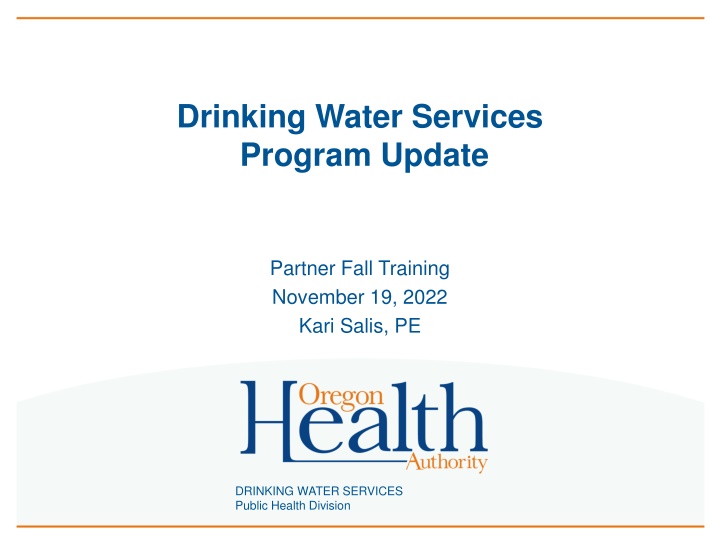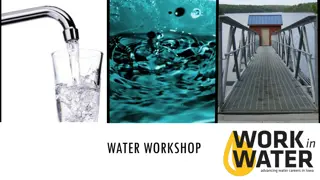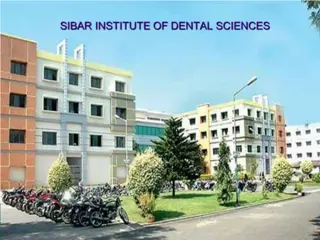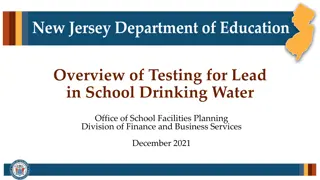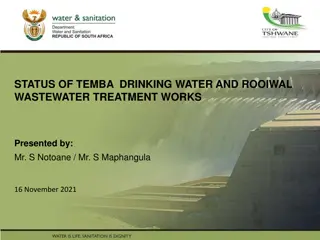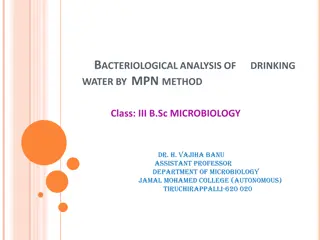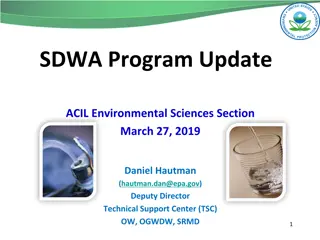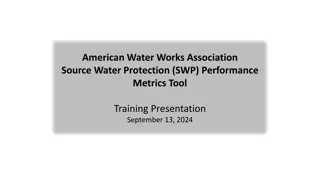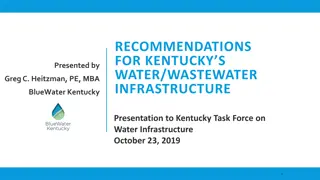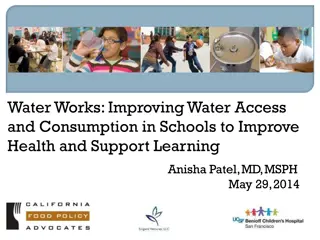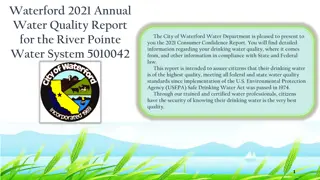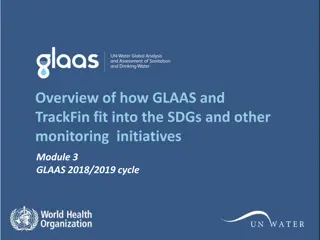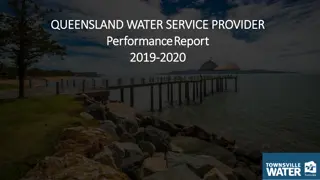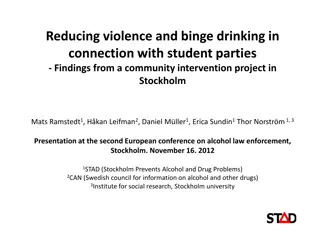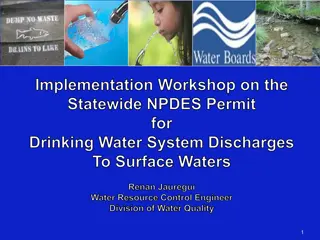Drinking Water Services Program Update for Partner Fall Training
Stay informed about the latest updates in the Drinking Water Services Program, including topics like LCRR service line inventory, BIL implementation timelines, and funding details for emerging contaminants and lead service line replacement. Be aware of important deadlines and requirements to ensure safe drinking water for all communities. Explore the comprehensive program details and guidelines provided in this update.
Download Presentation

Please find below an Image/Link to download the presentation.
The content on the website is provided AS IS for your information and personal use only. It may not be sold, licensed, or shared on other websites without obtaining consent from the author.If you encounter any issues during the download, it is possible that the publisher has removed the file from their server.
You are allowed to download the files provided on this website for personal or commercial use, subject to the condition that they are used lawfully. All files are the property of their respective owners.
The content on the website is provided AS IS for your information and personal use only. It may not be sold, licensed, or shared on other websites without obtaining consent from the author.
E N D
Presentation Transcript
Drinking Water Services Program Update Partner Fall Training November 19, 2022 Kari Salis, PE DRINKING WATER SERVICES Public Health Division
Topics LCRR Service line Inventory and RFP BIL positions, implementation plan Emerging contaminants Rulemaking schedule Miscellaneous updates DRINKING WATER SERVICES Public Health Division 2
LCRR Service line inventory Needs to be completed by October 16, 2024 Includes classifying materials of each service line Includes publicly-owned and privately-owned portion Spreadsheet template available on website Statistical analysis is allowed! Guidance soon. Contractors to assist systems serving <10,000: Group and individual training Develop strategy, records review, spreadsheet assistance, no field excavation 3 bids, review in process DRINKING WATER SERVICES Public Health Division 3
BIL implementation timelines SRF base grant: application complete, awarded BIL Supplemental: application by end of 2022 BIL Emerging contaminants: Spring 2023 BIL LSL: may not have projects. Cannot use set-asides. WIIN-SUDC: Annual, late summer Disadvantaged Community = below state median household income (MHI) DRINKING WATER SERVICES Public Health Division 4
BIL funding: Base and Supplemental Base funding was reduced from ~$12 M to $9 M due to congressional directed spending Supplemental is ~$23 M for 5 years 49% of funds must be given to disadvantaged communities with 100% subsidy DRINKING WATER SERVICES Public Health Division 5
BIL funding: Emerging contaminants Priority on PFAS 100% grants 25% of funds must be given to disadvantaged communities or PWSs serving < 25,000 people Also: contaminants with a HAL, not MCL Cyanotoxins, manganese Approximately $10 Million for 5 years DRINKING WATER SERVICES Public Health Division 6
BIL funding: Lead Service Line replacement $37 Million for 5 years 49% of funds must be given to disadvantaged communities with 100% subsidy If Lead SLs are found, full replacement is required (not just public side) Galvanized requiring replacement service lines are not a national priority but may be all we have in OR Only state set-asides can be used for assistance developing inventories Percentage of LSL replacement projects DRINKING WATER SERVICES Public Health Division 7
BIL positions E-board request for 4 new positions for DWS: Program Analyst 3 Natural Resources 4 Research Analyst 3 Fiscal Analyst One or two Program Analysts for IFA Workload up front, before we get the positions DRINKING WATER SERVICES Public Health Division 8
Unregulated Contaminant Rule Monitoring 5th round EPA requires all systems serving more than 3,300 people and selected smaller systems to monitor for selected unregulated contaminants Part of the regulatory determination process to determine frequency and level of detections nationwide UCMR5 will include 29 PFAS* and lithium Sampling will occur 2023-2025 EPA pays costs for systems serving < 10,000 * PFAS = Per- and polyfluoroalkyl substances 9
PFAS sampling Unregulated contaminants under the SDWA. UCMR 3 sampling 2013-15, included 6 PFAS. No detects in OR UCMR 5 planned for 2023-25. Includes 25 PFAS OHA/DEQ targeted PFAS sampling project 157 smaller PWSs targeted for sampling in 2021 Sample collection and analyses by DEQ, no cost to systems 6 sources at 5 PWSs had detections. None over OR-HAL. One PWS had previous results over OR-HAL, disconnected source 10
Health Advisory Levels Developed State PFAS Health Advisory Levels. PWS to issue public notice/advisory if exceedances EPA to propose MCL for PFOA and PFOS soon Comparison of OR PFAS Health Advisory Levels (parts per trillion) Oregon EPA CA WA MI MN (interim) 0.02 ppt PFOA 30 10 10 9 35 (interim) 0.004 ppt PFOS 30 40 15 8 15 PFHxS 30 65 84 47 PFNA 30 9 9 EPA HALs for PFBS = 2000 ppt, GenX = 10 ppt 11
Cyanotoxins 2022: Detections in 5 raw water sources: Gooseneck Creek Lake Selmac Row River South Umpqua Willamette Coast Fork No entry point detections Impact of wildfires in watersheds? Also low precipitation years Higher temperatures 12
qPCR Quantative polymerase chain reaction Test for cyantoxin-producing genes in water. Cyanobacteria can produce a toxin only if the gene is present. Thought to be an early warning, cheaper indicator of risk from cyanotoxins Correlation study with 2021-2022 cyanotoxin season Did NOT find adequate correlation DWS will NOT consider for regulation at this time DRINKING WATER SERVICES Public Health Division 13
Manganese EPA has established Health Advisory Levels: 0.3 mg/L over 10 or more days for infants 0.3 mg/L lifetime exposure for general population 1 mg/L one-day exposure for general population Historic data shows some high levels of manganese in PWS wells If treating or blending, sample to verify Letters being sent for follow up 14
Rulemaking Timelines Revisions: Service line inventory and Lead SL replacement plan, Lower trigger level for cyanotoxins, Minor clarifications Public comment period: Nov 1 Nov 30 Public hearing: November 17th, 2 pm Written comments to: publichealth.rules@state.or.us Revise rules based on comments: December 19th Effective date: January 1, 2023 DRINKING WATER SERVICES Public Health Division 15
Health Equity Drinking Water Services is contributing to OHA goal of eliminating health inequity by 2030: Identify areas facing drinking water insecurity Reasonable regulation Technical and financial assistance Encouraging consolidation/regionalization Public notice templates in different languages (in progress) Collaborate with Oral Health program 16
Subscribe to DWS GovDelivery emails Budget update 17
Miscellaneous Updates DWS Section Manager hiring process Open recruitment until November 20th Email address changes format will be First.M.Last@oha.oregon.gov The general rollout will start January 2023 Both old and new email addresses will work DRINKING WATER SERVICES Public Health Division 18
Questions / Discussion? Kari Salis, PE Interim Section Manager Normally: Technical Services Manager Karyl.l.salis@oha.Oregon.gov 503-385-7158 DRINKING WATER SERVICES Public Health Division 19
